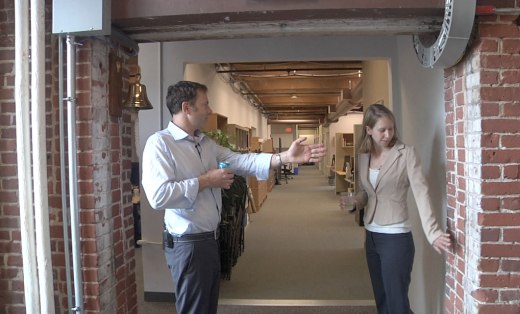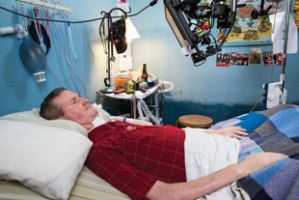
As Jamie Heywood shows me around the Boston offices of PatientsLikeMe, he pauses to point out that we have just crossed into a new zip code.
There’s no denying that Jamie Heywood is a busy man, and it shows in his demeanor as he hustles about the Boston building that is home to PatientsLikeMe. He spouts the details of the company’s history in a fury as we survey each addition to the growing office. “And there’s another one over here where, again, we just kicked out a neighbor and took over another space,” he continues. “So none of the colors match, none of the carpets match, but I love it. It’s part of the organic growth thing.”
Despite his perpetual rush, however, our conversations are never short. It can take me weeks to get him on the phone; then he talks my ear off for two hours. “I am very bad at being pithy,” he admits later that day, several minutes into an impassioned monologue about how the current medical establishment does a poor job of assessing and improving the human condition.
But his long-windedness is not unwelcome, and it is a clear sign of a decidedly proactive approach to life. After his brother Stephen was diagnosed with ALS in the late ’90s, Jamie moved across the country to found, with Stephen, the nonprofit ALS Therapy Development Foundation, with the intention of directing research that would lead to a cure for the disease. In 2005, Jamie, with his other brother Ben and a friend, launched PatientsLikeMe, with the hope of challenging how biomedical research works. The site is a social media platform that allows patients to input and track their own health data, and compare themselves to others. It’s one of the sites patients have used to conduct trials testing experimental drugs, and Jamie hopes it could help drug developers, too. “[If] we can make it profitable to develop a treatment for a disease, which it’s not really right now, that changes the whole world,” he says.
System overhaul
Jamie is the first to acknowledge his cynicism as he expresses his views on the biomedical research and health care systems. He describes the current system as a landscape of data silos, filled by experiments that are “underpowered, non-computable, [and] non-integratable.”
“If our scientific system was trying to build an automobile, it would give 50,000 scientists a quarter million dollars [each] and wonder why no one had a running prototype,” he told me this summer in his office.
But Jamie is not a pessimist, and he predicted a surprising short time—10 to 15 years—before the entire biomedical research enterprise has fundamentally changed the way it does business. He envisions a system where all data is amassed, integrated, and analyzed in unprecedented ways to reveal unprecedented insights into human health and disease. To be fair, big data is not much of a fantasy these days, and data sharing is becoming noticeably more common. But Jamie’s vision is much grander. Rather than recruit a new set of patients for each clinical study, scientists would consult the vast network of health data to understand the patient population and inform the direction of research—and they’d feed their results back into the ever-growing and ever-learning system. “Suddenly people will wonder why you did experiments any other way. And we won’t know the moment that it died, but [the old way] will be gone,” he says.
It’s an exciting idea, and Jamie is not alone in his hopes for a more integrated biomedical system. Certainly the patients who have been active users of the new media preach the power of extending data collection to the masses. And many researchers would agree, in theory. But resolution of the logistical, ethical, and political matters surrounding the widespread sharing of health and genomic data is still pending, and such visions of grandeur are still just visions; a major overhaul of clinical research will take time, and its course is hard to predict.
Seeking cures
In early 1998, Jamie accepted a position at the Neurosciences Institute in La Jolla, California—a job he chose over a position at an East Coast hedge fund involved in air conditioner technologies because describing it made him feel more appealing to the opposite sex. “How do you commercialize the biological basis of consciousness” sounded pretty sexy to him, so he joined the ranks of Nobel Laureate Gerald Edelman and others seeking to understand the human brain. (He was married at the time, but that was beside the point. He wasn’t trying to pick up women; he just thought their collective judgments demanded significant consideration when making major life decisions.)
Eight months after Jamie, an MIT-trained engineer, started his new job in biology, Stephen was diagnosed with ALS. As soon as Jamie hung up the phone with his brother, who’d called to bear the tragic news, Jamie hit the literature, gathering, reading, and organizing all the scientific studies on the disease that he could find. He quit The Neurosciences Institute the next morning, but stayed on until the end of February, soaking up the knowledge of his newfound neuroscientist friends, including Edelman himself. For about two months, he recalls enjoying an almost photographic memory, turning into the ace student he had never been in school. Then he and his wife packed up their lives and drove the 3,000 miles from southern Cali to Boston to turn the knowledge he’d gathered into a cure for his brother’s disease.
One therapy he ushered through preclinical research at the ALS Therapy Development Foundation (later, ALS Therapy Development Institute, or ALS TDI) was a stem cell transplant that Stephen, along with two other patients, eventually got. “It was literally less than two years to go from the initial concept discussion through the validation experiments, rodent toxicology and safety, primate toxicology and safety, and then ultimately [into] my brother and other patients who got the stem cell transplant.” Ten years later, thanks to the network built by PatientsLikeMe, Jamie finally learned whether the treatment had helped Stephen in any way. “Because we had so much data in ALS—we had thousands and thousands of patients over the course of their disease—we were able to build a predictive model. . . . Based on the experience of, in Stephen’s case, about 15 other patients, . . . he did exactly as expected. It didn’t do any good.”
Learning that he had made the right decision in not pursuing the stem cell treatment further was reassuring to Jamie, but more powerful was the system’s ability to extract new knowledge about a treatment and a patient, even years after his death. Indeed, Jamie and his colleagues have applied these tools to accurately predict the outcomes of clinical trials and refute the conclusions of others. “I think we’re entering the era where we’ve lost that little silo like the one I did with Stephen—did it work?; three people; don’t know—to an era where every one of those can add up to mean something. And it was almost accidental; like I dreamed it was possible, but the fact that it happened in that way was amazing.”






